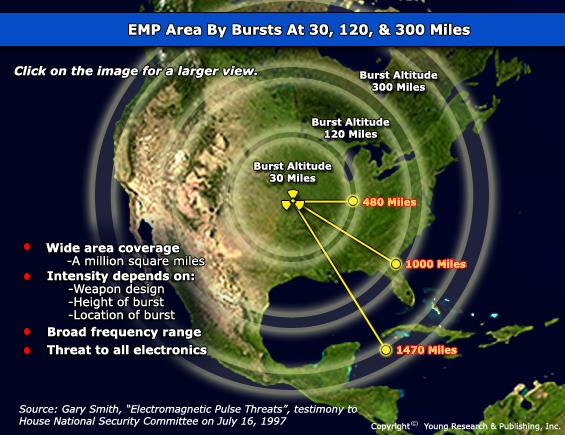Amb. Henry F. Cooper, Chairman Lt. Gen. Daniel Graham, Founder
High Frontier . . Building Truly Effective Defenses . . . Reagan’s Vision Lives!
E-Mail Message 140508
Diplomacy to Counter FOBS!
By Ambassador Henry F. Cooper
May 8, 2014
We have opportunities for diplomatic initiatives to benefit the United States and our allies while defending against fractional orbital bombardment system (FOBS) attacks from North Korea and Iran. Such initiatives should be easily attached to agreements for defense cooperation, as evidenced by the Enhanced Defense Cooperation Agreement (EDCA) with the Philippines and discussions in Abu Dhabi—both of which set the stage for rapid follow through to end our total FOBS vulnerability and cooperate on regional defenses for our allies as well.
As discussed in several previous email messages, both North Korea and Iran have demonstrated an interest in gaining a fractional orbital bombardment system capability—basically a way to deliver a nuclear weapon over the South Pole to attack the United States. And we have potential, but as yet unrealized, effective countermeasures. (To review our messages from April 3, 11, 17, and 27 click here, here, here and here.)
Both North Korea and Iran have launched satellites that could carry a nuclear weapon and detonate it in that satellite’s initial passage above the earth’s atmosphere over the center of the United States to create an electromagnetic pulse (EMP) as illustrated below.
If detonated above a hundred or so miles altitude, this capability poses a High Altitude Electromagnetic Pulse (HEMP) existential threat to all Americans. And today, we are essentially defenseless against such an attack that could take down the electric power grid and return the U.S. status to that of the 19th century without the benefits of an indigenous agricultural society.
This vulnerability should be addressed immediately—and happily there are inexpensive ways to empower our existing missile defenses to do so, as elaborated in our above referenced previous email messages. Furthermore, recent press reports suggest opportunities for enabling these countermeasures can be included in ongoing negotiations with potential partners.
In particular, these allies could host an appropriate radar, e.g., the TPY-2 X-band radar, which could cue our existing operational ballistic missile defense (BMD) systems to shoot down threatening satellites before they can overfly the United States. And we could work with them on a common defense.
Diplomatic Opportunity to Counter a North Korean FOBS.
To defend against a North Korean FOBS, a TPY-2 radar might be deployed at an appropriate site in the Philippines as part of the Enhanced Defense Cooperation Agreement (EDCA), recently signed by Presidents Obama and Aquino.
As noted in the White House Press Release (Click here to review.), this agreement is intended to meet 21st century challenges—a North Korean FOBS is certainly qualifies—to “facilitate the enhanced rotational presence of U.S. forces; facilitate humanitarian assistance and disaster relief in the Philippines and the region; improve opportunities for bilateral training; and support the long-term modernization of the Armed Forces of the Philippines (AFP) as it works to establish a minimum credible defense.”
According to the White House press release, the U.S. has begun to provide $40 million in “technical expertise, training, and equipment” to strengthen the Philippines’ security operations and maritime domain awareness capabilities; is supporting transition planning of the AFP and assisting the Philippine National Police to help them assume a leading role in providing internal security and combating terrorism; and helping to construct a Philippine National Coast Watch Center in Manila to assist the Philippine Coast Guard’s increased responsibility for enhancing information sharing and interagency coordination in maritime security operations.
These welcome activities might logically also support joint efforts to defend against North Korean (and other regional) threats, including from ballistic missile attack. For example, the U.S. might co-locate an Aegis Ashore site with a TPY-2 radar to provide the Philippines with an ABM capability and the U.S. with a counter FOBS capability.
Cuing information from a TPY-2 radar site in the Philippines would give Aegis BMD ships in the Pacific a capability to shoot down a North Korean FOBS. As SM-3 interceptor block improvements increase its burnout velocity (e.g., with the Block IIA by 2018), it will gain increasing capability against the FOBS threat from North Korea and Iran. The greater an interceptor’s burnout velocity, the higher it can reach to intercept a threatening nuclear armed satellite (potential intercept altitude increases as the square of the velocity).
The TPY-2 radar in the Philippines would also enable the ground based interceptors on Vandenberg AFB, California against a FOBS attack. So, an inexpensive operational layered defense against a North Korean FOBS is readily available, provided the U.S. and Philippine administrations would approve siting a TPY-2 radar at an appropriate Philippine site.
Diplomatic Opportunity to Counter an Iranian FOBS.
To counter an Iranian FOBS attack, an appropriate TPY-2 radar site south of the Iranian satellite launch sites would enable a similar anti-FOBS capability for our Aegis BMD ships and our Vandenberg ground-based interceptors.
A similar diplomatic initiative also should be undertaken immediately with potential allies in the Gulf region, possibly as part of recently reported and presumably ongoing discussions Deputy Assistant Secretary of State for Space and Defense Policy Frank Rose is having with allies in the region on joint defenses against a nuclear armed Iran.
According to a Reuters press report (Click here.), Rose stated in an Abu Dhabi conference on missile and defense that Washington was “acutely” aware of Gulf Arab states’ anxieties about Iran and wanted to help them launch a Gulf-wide coordinated missile defense capability. He elaborated, “As long as Iran continues to develop ballistic missiles that can threaten the United States or deployed forces and our friends and allies in the region, we will work effectively with our partners here in the UAE as well as the rest of the Gulf to defend against that threat.”
Rose’s statements are entirely consistent with deploying a TPY-2 radar at an appropriate location with one of our partners in the Gulf region. As in the case of the Philippines, there could be mutual benefits to also co-locating BMD systems in the Gulf region to help defend that host nation against Iranian missiles. Indeed, the TPY-2 radar is a component of the THAAD system, which may be of interest to allies in the Gulf.
Bottom Line.
Bottom, line—there are diplomatic opportunities for mutually beneficial agreements with host nations that would yield immediate effective defenses against FOBS threats from both North Korea and Iran.
Time’s awasting! We should get on with it!!!
Near Term High Frontier Plans.
We will do all we can to encourage “the powers that be” to “make the Navy’s Aegis BMD system all it can be” and to adopt the anti-FOBS strategy laid out in our recent email messages and above. We will also seek to revive a viable program to deploy space-based defenses.
We will continue our efforts to inform state and local authorities about the EMP threat and expand our work with the National Guard to help them gain knowledge and workable plans to help harden the electric power grid and counter the EMP threat. This work should go hand in hand with the efforts to gain support from State legislators to expand on the excellent work in Maine and Virginia, who have passed legislation requiring serious studies of the EMP threat and the needed countermeasures to protect the electric power grid.
The most recent bill passed in record time without single negative vote in Virginia can be used as a ready pattern.
We will continue working with South Carolinians to build a coalition to engage constructively with private citizens and their local and state representatives and other authorities to work with the SC National Guard in understanding and responding to this serious threat. We will expand this effort to neighboring and other states.
We are informing SC state legislators and senators about the threat and what can be done to deal with it—and hopefully they will follow Maine and Virginia in seeking to harden the electric power grid. We also expect support from Cong. Jeff Duncan (R-SC) whose district includes my SC farm—and who is a member of the Congressional EMP Caucus seeking passage of the Shield Act and the Infrastructure Protection Act, as well as other SC representatives.
We will be working with members of the EMP Coalition and others who are seeking to take our message across the country—especially with Bob Newman, a former Adjutant General of Virginia to help us link our SC plans more broadly and especially into Virginia and the National Capital region.
What can you do?
Join us in praying for our nation, and for a rebirth of the freedom sought, achieved and passed to us by those who came before us.
Help us to spread our message to the grass roots and to encourage all “powers that be” to provide for the common defense as they are sworn to do.
Begin by passing this message to your friends and suggest they visit our webpage, www.highfrontier.org for more information. Also, please encourage your sphere of influence to sign up for our weekly e-newsletter!
And support us with your tax deductible gifts to help enable our continuing efforts.
Please click here to read Past Weekly Updates!
Please click here to read past Flash Messages!
Please help High Frontier continue this important and timely work!
 Be sure to follow us on our Social Sites!
Be sure to follow us on our Social Sites!
If you found this letter via our Social Sites, and you would like to subscribe, click below!






